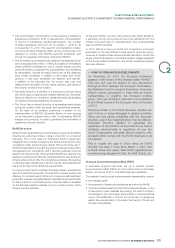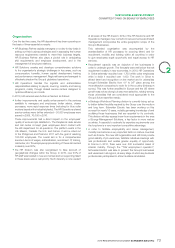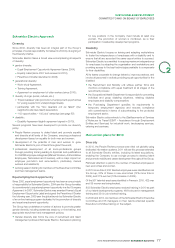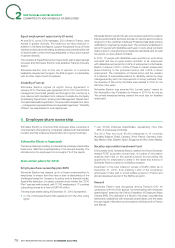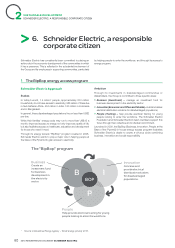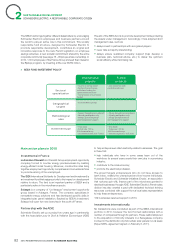APC 2010 Annual Report Download - page 76
Download and view the complete annual report
Please find page 76 of the 2010 APC annual report below. You can navigate through the pages in the report by either clicking on the pages listed below, or by using the keyword search tool below to find specific information within the annual report.
SUSTAINABLE DEVELOPMENT
2COMMITTED TO AND ON BEHALF OFEMPLOYEES
2 Employee health and safety
In the area of employee health, Schneider Electric takes reference
from the highest level. Its policy is built around the World Health
Organisation’s defi nition “Health is a state of complete physical,
mental and social wellbeing and not merely the absence of disease
or infi rmity”. The health and safety of its employees and of external
collaborators therefore is a concept that Schneider Electric is
committed to promoting within the Group. Its goal is to become a
model of health and safety in the work place.
The Group’s policies and main commitments are defined at
global level and are adapted by each Country President to local
requirements in order to take account of diverse needs and
implement individual resources.
Its goals in this area are as follows:
•promote good physical and mental health throughout the
professional career of each employee;
•improve the quality of life in the work place;
•anticipate events that could have an impact on the health of the
employees.
In safety, it aims to continue working to ensure the best protection of
its employees through the prevention of accident and the detection
of risks.
Schneider Electric Approach
Safety
Schneider Electric provides its employees with safety information
and tools to ensure a safe, clean and healthy working environment
notably through safety training and the implementation of safety
practices both at a professional and personal level.
Health
One way that Schneider Electric ensures the best physical and
mental health of its employees is through the prevention of illnesses
that could hamper their efficiency, creativity and well being.
Increasingly ergonomic work stations within its production system,
for example, are an ongoing measure to prevent muscular and bone
problems. In France, the Group participates in programs to promote
the employment and integration of disabled persons.
Emphasis is placed on anticipating professional risks and on
integrating preventive measures into company policies and projects
to enhance the overall quality of life. For example, the Group already
has in place a system for measuring employee satisfaction in which
all employees worldwide can participate (its OneVoice survey, see
page 75). In France, measures are in place to assess and prevent
working situations that carry psychosocial risks.
Lastly, Schneider Electric has integrated a Health section into its
Emergency Plan and Business Continuity Plan in order to ensure
the highest degree of responsiveness. It also has a plan in place for
the prevention of H1N1 swine fl u.
Main Plans of Action 2010
Safety
As part of the Planet & Society Barometer, Schneider Electric set
a goal for 2009-2011 to reduce the annual rate of accidents in the
work place by 10%.
End-2010, the accident rate had fallen by 44% in relation to the
average rate in 2009. It currently stands at 2.51 (see page 90).
The number of day’s work lost due to accident fell by 25% in 2010
in relation to 2009, while the target had been 10%. In 2009 it had
fallen by 32% in relation to 2008.
As part of the One program, Schneider Electric set up three regional
organisations in 2010 (incorporating North America, EMEAS Europe,
Middle East, Africa, South America and Asia Pacifi c) which will report
to the Industral Operation Department. Their mission is to support
the Group’s plans in three areas, Safety, Environment and Property.
In 2010 the Group focused on building the new organisation in all
three regions, on strengthening the management’s commitment to
safety, on creating teams responsible for coordinating and steering
projects and on encouraging more employees to get actively involved
in improving overall safety. The organisation also pursued risk
assessment, training, internal audits and ongoing deployment at the
plants of a security management system based anOHSAS 18001.
In 2011, Schneider Electric will pursue all of the activities that it began
in 2010 and will also implement the MIR (Medical Incidence Rate),
a work-based program related to long-term treatments. The Group
plans to focus on serious injuries in order to identify and prevent the
dangers that lead to these injuries and the resulting loss of working
days.
Health
Employee health is treated at country level in accordance with local
regulations. Schneider Electric has not set out a Group plan in this
domain under its One program.
2010 REGISTRATION DOCUMENT SCHNEIDER ELECTRIC74







